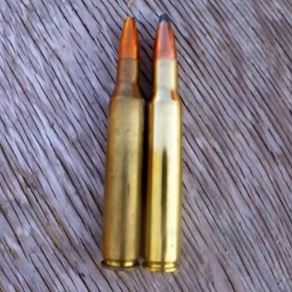.25-06 Remington

The .25-06 Remington is a centerfire medium-high powered rifle cartridge originating around 1917 or so, and it is one of many wildcat cartridges that ended up not only being officially standardized, but has also seen significant commercial success. It took just over half a century to finally be standardized by Remington in 1969. The .25-06 is based on the .30-06 Springfield cartridge, necked-down to accept .257 caliber projectiles with no other changes. Bullet weights range from 75 to 120 grains (or 4.9 to 7.8 grams).
Contents
History and Design
Charles Newton and the .250-3000 Savage
Charles Newton necked down the .30-06 Springfield cartridge in 1912 to accept a 117-grain .25-35 Winchester bullet. Newton's earliest modifications encouraged commercial release of a shortened case (from the original 63mm, to 49mm), leading to the .250-3000 Savage in 1915.
Frankford Arsenal's Experimental .25-06 (WWI)
Frankford Arsenal had created an experimental .25-06 cartridge during the first World War. Later mass distribution of surplus U.S. military equipment through the Civilian Marksmanship Program after the war now encouraged independent gunsmiths to experiment with the cartridge.
Post World War I Creations and Advances
A.O. Niedner, a gunsmith from Dowagiac, Michigan introduced rifles for his .25 Niedner cartridge in 1920. Niedner Arms Corporation retained the 17° 30′ .30-06 shoulder chambering .25 caliber barrels rifled with a twist rate of 1:12 (or every 300 mm).
Similar cartridges were identified as the ".25 Hi-Power", ".25 Whelen" (analogous to .35 Whelen), or ".25-100-3000" (to indicate the ability to achieve 3000 feet per second with a 100 grain bullet rather than the 87 grain bullet used in the .250-3000 Savage). Greater case capacity offered minimal velocity improvement over the .250-3000 Savage case with contemporary smokeless powders.
Availability of DuPont's "Improved Military Rifle" (IMR) powders encouraged commercial release of the .257 Roberts using the 57mm-long Mauser case in 1934. Release of IMR 4350 in 1940 and availability of surplus 4831 powder salvaged from Oerlikon 20mm cannon cartridges after World War II greatly improved performance of the full-length .25-06 case.
Ballistic Performance
The cartridge is capable of propelling a 117 grain (7.6 gram) bullet at up to 3,200 feet per second (980 m/s) and have muzzle energy levels up to about 2,500 ft lbs (3,400 J). Bullets lighter than 75 grains are available in .257 caliber, but were designed for the smaller .25-20 Winchester and .25-35 Winchester cartridges and are too lightly constructed for the significantly higher velocities of the .25-06 Remington.
The cartridge has less felt recoil than a .30-06 in a similar weight rifle, due to the lighter weight bullets used. Shooters who are recoil sensitive will find the recoil from the .25-06 bearable, but not pleasant enough to shoot all day long. This cartridge is not as powerful as the .257 Weatherby Magnum which is usually 200–300 ft/s (61–91 m/s) faster with a given bullet weight.
| Bullet Weight / Type | Velocity | Muzzle Energy |
|---|---|---|
| 100 gr (6 g) PSP-CL | 3,230 ft/s (980 m/s) | 2,316 ft⋅lbf (3,140 J) |
| 115 gr (7 g) PSP-CL Ultra | 3,000 ft/s (910 m/s) | 2,298 ft⋅lbf (3,116 J) |
| 120 gr (8 g) PSP-CL | 2,990 ft/s (910 m/s) | 2,382 ft⋅lbf (3,230 J) |
Specifications
- Parent case: .30-06 Springfield
- Bullet diameter: .257 in (6.5 mm)
- Neck diameter: .290 in (7.4 mm)
- Shoulder diameter: .441 in (11.2 mm)
- Base diameter: .470 in (11.9 mm)
- Rim diameter: .473 in (12.0 mm)
- Rim thickness: .05 in (1.3 mm)
- Case length: 2.494 in (63.3 mm)
- Overall length: 3.250 in (82.6 mm)
- Case capacity: 65.8 gr H2O (4.26 cm3)
- Rifling twist: 1 in 10 in (250 mm)
- Primer type: Large rifle
- Maximum pressure: 63,000 psi (430 MPa)
Applications and Uses
Bullets in the .25 caliber range often have high ballistic coefficients without being too heavy. This trait, when combined with the large case capacity of the parent case, allows the high muzzle velocity and long range of the .30-06 Springfield, but without the heavier recoil. The combination of high ballistic coefficients with high muzzle velocities give the .25-06 a flat trajectory, as well as excellent energy retention at those long ranges.
The .25-06 is generally considered to be a good round for medium-sized game such as deer and antelope because of its combination of substantial kinetic energy and moderate recoil. The cartridge's flat trajectory also makes it highly popular in the plains states where open fields often require longer-range shots on game. The flatness of the .25-06 Remington's trajectory helps to reduce range-estimation errors by hunters, leading to cleaner and more humane kills.
Various bullet options of type and weight for the .25-06 allow it to be used for taking game ranging from small animals like prairie dogs and coyotes, to much larger and heavier elk. These bullets range from lightly constructed 75-grain bullets with extreme muzzle velocities in the 3,700 ft/s (1,130 m/s) range, to more robust 120-grain bullets with muzzle velocities in the 3,000 ft/s (915 m/s) range.
Most makers of bolt-action or single-shot rifles offer the .25-06 as a standard chambering, and factory ammunition is available from Remington, Winchester, Federal Cartridge and most other major manufacturers.